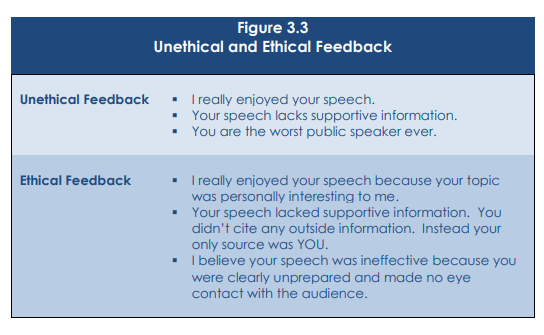Just as you hope others are attentive to your speech, it is important to know how to listen ethically—in effort to show respect to other speakers.
Jordan stood to give his presentation to the class. He knew he was knowledgeable about his chosen topic, the Chicago Bears football team, and had practiced for days, but public speaking always gave him anxiety. He asked for a show of hands during his attention getter, and only a few people acknowledged him. Jordan’s anxiety worsened as he continued his speech. He noticed that many of his classmates were texting on their phones. Two girls on the right side were passing a note back and forth. When Jordan received his peer critique forms, most of his classmates simply said, “Good job” without giving any explanation. One of his classmates wrote, “Bears SUCK!”
As we can see from the example above, communicating is not a one-way street. Jordan’s peers were not being ethical listeners. All individuals involved in the communication process have ethical responsibilities. An ethical communicator tries to “understand and respect other communicators before evaluating and responding to their messages” (NCA, 1999, para. 2). As you will learn in Chapter 4, listening is an important part of the public speaking process. Thus, this chapter will also outline the ethics of ethical listening. This section explains how to improve your listening skills and how to provide ethical feedback. Hearing happens physiologically, but listening is an art. The importance of ethical listening will be discussed first.
Develop Ethical Listening Skills
The act of hearing is what our body does physically; our ear takes in sound waves. However, when we interpret (or make sense of) those sound waves, that’s called listening. Think about the last time you gave a speech. How did the audience members act? Do you remember the people that seemed most attentive? Those audience members were displaying traits of ethical listening. An ethical listener is one who actively interprets shared material and analyzes the content and speaker’s effectiveness. Good listeners try to display respect for the speaker. Communicating respect for the speaker occurs when the listener: a) prepares to listen and b) listens with his or her whole body.

One way you can prepare yourself to listen is to get rid of distractions (Sellnow, 2009). If you’ve selected a seat near the radiator and find it hard to hear over the noise, you may want to move before the speaker begins. If you had a fight with your friend before work that morning, you may want to take a moment to collect your thoughts and put the argument out of your mind—so that you can prevent internal distraction during the staff meeting presentation. As a professional, you are aware of the types of things and behaviors that distract you from the speaker; it is your obligation to manage these distractions before the speaker begins.
In order to ethically listen, it’s also imperative to listen with more than just your ears— your critical mind should also be at work. According to Sellnow (2009), two other things you can do to prepare are to avoid prejudging the speaker and refrain from jumping to conclusions while the speaker is talking. Effective listening can only occur when we’re actually attending to the message. Conversely, listening is interrupted when we’re pre-judging the speaker, stereotyping the speaker, or making mental counterarguments to the speaker’s claims. You have the right to disagree with a speaker’s content, but wait until the speaker is finished and has presented his or her whole argument to draw such a conclusion.
Ethical listening doesn’t just take place inside the body. In order to show your attentiveness, it is necessary to consider how your body is listening. A listening posture enhances your ability to receive information and make sense of a message (Jaffe, 2010). An attentive listening posture includes sitting up and remaining alert, keeping eye contact with the speaker and his or her visual aid, removing distractions from your area, and taking notes when necessary. Also, if you’re enjoying a particular speaker, it’s helpful to provide positive nonverbal cues like head-nodding, occasional smiling, and eye-contact. These practices can aid you in successful, ethical listening. However, know that listening is sometimes only the first step in this process—many times listeners are asked to provide feedback.
Constructive criticism is about finding something good and positive to soften the blow to the real critique of what really went on. ~ Paula Abdul
Provide Ethical Feedback
Ethical speakers and listeners are able to provide quality feedback to others. Ethical feedback is a descriptive and explanatory response to the speaker. Brownell (2006) explains that a response to a speaker should demonstrate that you have listened and considered the content and delivery of the message. Responses should respect the position of the speaker while being honest about your attitudes, values, and beliefs. Praising the speaker’s message or delivery can help boost his or her confidence and encourage good speaking behaviors. However, ethical feedback does not always have to be positive in nature. Constructive criticism can point out flaws of the speaker while also making suggestions. Constructive criticism acknowledges that a speaker is not perfect and can improve upon the content or delivery of the message. In fact, constructive criticism is helpful in perfecting a speaker’s content or speaking style. Ethical feedback always explains the listener’s opinion in detail. Figure 3.3 provides examples of unethical and ethical feedback.

As you can see from the example feedback statements (Figure 3.3), ethical feedback is always explanatory. Ethical statements explain why you find the speaker effective or ineffective. Another guideline for ethical feedback is to “phrase your comments as personal perceptions” by using “I” language (Sellnow, 2009, p. 94). Feedback that employs the “I” pronoun displays personal preference regarding the speech and communicates responsibility for the comments. Feedback can focus on the speaker’s delivery, content, style, visual aid, or attire. Be sure to support your claims—by giving a clear explanation of your opinion—when providing feedback to a speaker. Feedback should also support ethical communication behaviors from speakers by asking for more information and pointing out relevant information (Jensen, 1997). It is clear that providing ethical feedback is an important part of the listening process and, thus, of the public speaking process.
A man without ethics is a wild beast loosed upon this world. ~ Albert Camus



